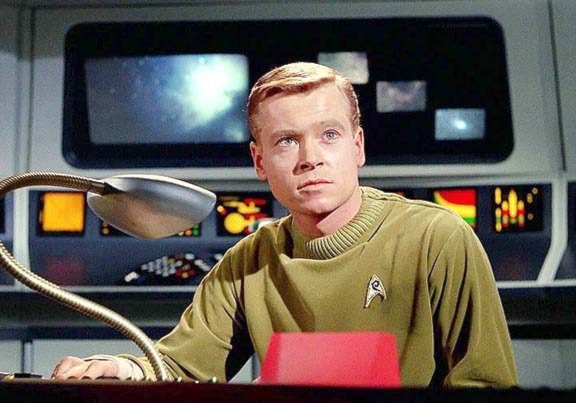Greg Nesteroff/Nelson Star
It’s a measure of Peter Duryea’s worth that appearing in one of the most popular shows in television history wasn’t his most noteworthy accomplishment.
To most of the world, Duryea was best known for a bit role in the pilot episode of the original Star Trek series. But on Kootenay Lake, he was a revered East Shore elder and environmentalist who fought against clearcut logging and started a now-thriving nature retreat.
Duryea, who was also a writer, director, documentary filmmaker, boat guide, and naturalist, died at home Sunday at 73 after a long illness.
“He was a visionary — one of the most amazing I’ve ever met,” says Susan Hulland, who like Duryea came to the area in the 1970s. “He always insisted on figuring out a good way to do things. I can remember hearing from him over and over again: ‘Is there a better way?’ He was always looking for win-win scenarios, even during down and dirty environmental squabbles.”
One of those disputes led to the creation of the non-profit Guiding Hands Recreation Society and tipi camp. In a memoir published last July in the East Shore Mainstreet, Duryea recalled that in the mid-1980s the community was struggling against clearcut logging. They established the Stop Clearcut campaign, famous for its ubiquitous green stop signs.
News that 22 clearcuts were planned for the Pilot Peninsula set off “a wave of resistance” along the East Shore, Duryea wrote. “The idea grew that maybe we could show that using the land for conservation and educational purposes could lead to a sustainable industry of outdoor recreation.”
In 1988, Alice Bruce offered her land at Cortiannas Bay, where a tipi camp was established as a retreat to inspire young and old. It took eight years before the camp could afford to hire five seasonal workers, and Duryea continued to nurture it until it became self-sustaining.
He chalked up his tenacity to obsessive compulsive disorder: “I can find no other explanation for my unswerving devotion to the cause. I guess the tipi camp was meant to be.”
Hollywood Actor
Born in Los Angeles in 1939, Duryea followed in his father’s footsteps. Dan Duryea was a TV actor with many roles to his credit, and the two appeared together in two films and an episode of Daniel Boone.
However, Peter hadn’t intended on it: he was majoring in math and physics at Amherst College in Massachusetts before someone asked him to appear in a play and he discovered he loved it. He worked in theatre in Houston and New York and then moved to Hollywood.
Duryea’s filmography over nine years included six movies and 30 television roles, including appearances in Dr. Kildare, Dragnet, and Bewitched.
In November 1964, he was cast as Lt. Jose Tyler, navigator of the USS Enterprise in the pilot episode of Star Trek. “It reminded me of a western, but set in the future and it was very interesting,” Duryea told the Nelson Daily News in 2001. “I was among the other many, many people who auditioned. I was really happy to be part of it and took the job really seriously. I can remember long talks with the director, Robert Butler, how to do the part.”
Had NBC executives picked up the series based on that episode, Duryea would have had a regular role. However, they rejected it and the pilot never aired in its original form. Later, a second pilot was approved with an entirely different cast, except Leonard Nimoy as Spock.
But Duryea didn’t express regret at what might have been. Feeling drained by the pace and competitiveness of his lifestyle, he moved his family to Canada in 1973.
“I really needed more in my life than just what I could see coming from that career,” he said. “I need heart and I needed a community.”
He went first to Saltspring and Cortes islands before arriving in the Kootenays, where “the land and the setting made me feel like I’d come home.”
In Gray Creek, Duryea put his stage skills to work in new ways. He founded the Kootenay Lake Players, a children’s theatre collective that in three years produced nine original plays. The volunteer cast and crew created costumes, props, and sets and staged their works in the Gray Creek Hall. “Having come from Hollywood this was a delightful change for me,” Duryea said.
But he did eventually revisit his most famous role in 2005, attending his first Star Trek convention in Las Vegas, where he was overwhelmed. “It was the total antithesis of my life here,” he said. “I’m deep in nature, working with educational stuff and that’s totally glitz and gambling … It couldn’t be farther apart.”
During Gray Creek’s 2008 centennial, Duryea was presented with a community legacy award, recognizing his efforts to “protect natural areas and teach young people how to love and live with nature.”
The campaign didn’t succeed in the end, she said, but not for lack of trying.
Duryea entrusted his archival files relating to his community work with the Gray Creek Historical Society, including more than 40 films.
With files from Brian Lawrence and thanks to Frances Roback, Tom Lymbery, and Susan Hulland.
